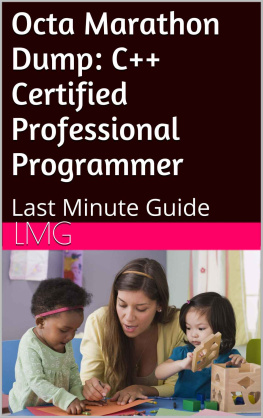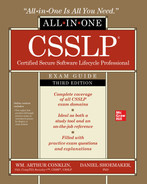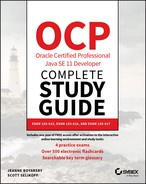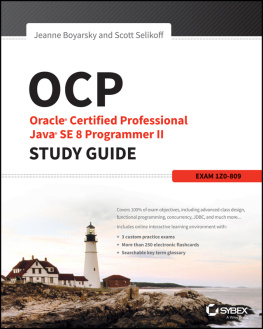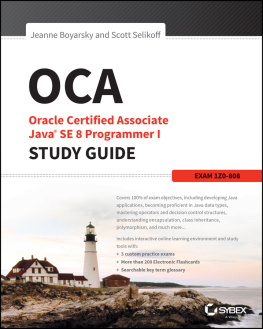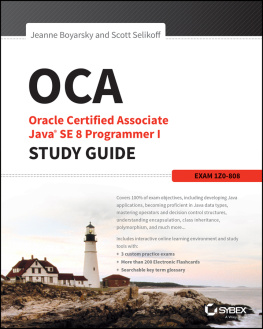Octa Marathon Dump: C++ Certified Professional Programmer Copyright 2015 by LMG All rights reserved. No part of this publication may be reproduced, distributed, or transmitted in any form or by any means, including photocopying, recording, or other electronic or mechanical methods, without the prior written permission of the publisher, except in the case of brief quotations embodied in critical reviews and certain other noncommercial uses permitted by copyright law. Disclaimer: The sample questions in this document are solely consolidated for academic practice and in no way related to actual test question. Any resemblance is purely coincidental. Copyright solely resides with author. Author is not responsible for any consequence if the user of this document applies the stated lines to professional practice.
DMCA approved. C++ Certified Professional Programmer Exam Code: C++ Institute CPP Topic 1, Volume A QUESTION NO: 1 What happens when you attempt to compile and run the following code? #include #include #include using namespace std; int main(){ int t[] ={ 3, 4, 2, 1, 6, 5, 7, 9, 8, 0 }; vectorv(t, t+10); multiset s1(v.begin(),v.end()); s1.insert(v.begin(),v.end()); pair::iterator,multiset::iterator> range; range = s1.equal_range(6); while (range.first != range.second) { cout<<*range.first<<" "; range.first++; } return 0; } A. program outputs: 6 6 B. program outputs: 5 7 C. program outputs: 5 5 6 6 7 7 D. program outputs: 1 1 6 6 5 5 Answer: A Explanation: QUESTION NO: 2 What happens when you attempt to compile and run the following code? #include #include #include using namespace std; templatestruct Out { ostream & out; Out(ostream & o): out(o){} void operator()(const T & val ) { out<<" "; } }; struct Sequence { int start; Sequence(int start):start(start){} int operator()() { return start++ ; }}; int main() { vector v1(10); generate(v1.rbegin(), v1.rend(), Sequence(1)); rotate(v1.begin(),v1.begin() + 1, v1.end() ); for_each(v1.begin(), v1.end(), Out(cout) );cout< return 0; } Program outputs: A. 1 2 3 4 5 6 7 8 9 10 B. 10 9 8 7 6 5 4 3 2 1 C. 9 8 7 6 5 4 3 2 1 10 D. 1 10 9 8 7 6 5 4 3 2 Answer: C Explanation: QUESTION NO: 3 What happens when you attempt to compile and run the following code? #include #include #include #include #include #include using namespace std; class B { int val; public: B(int v=0):val(v){} int getV() const {return val;} operator int() const { return val; };}; templatestruct Out { ostream & out; Out(ostream & o): out(o){} void operator() (const T & val ) {out<< int main () { int t[] = {1, 2, 3, 4, 5, 6, 7, 8, 9, 10}; fstream f("test.out", ios::trunc|ios::out); list l(t, t+10);for_each(l.begin(), l.end(), Out(f)); f.close();f.open("test.out");for( ; f.good() ; ) {B i;f>>i;cout<<" ";}f.close();return 0;}A. file test.out will be opened writingB. file test.out will be truncatedC. file test.out will be opened for readingD. compilation errorE. program will display sequence 1 2 3 4 5 6 7 8 9 10Answer: DExplanation:QUESTION NO: 4What will happen when you attempt to compile and run the code below, assuming that you enterthe following sequence: one two three?#include#includeusing namespace std;int main (){string a;cin>>a;cout<return 0;}Program will output:A. oneB. one two threeC. runtime exceptionD. compilation errorE. the result is unspecifiedAnswer: AExplanation:QUESTION NO: 5What will happen when you attempt to compile and run the following code?#include#include#include#include#includeusing namespace std;int main() {int t[] = { 3, 4, 2, 1, 0, 3, 4, 1, 2, 0 };vector v(t, t + 10);multimap m;for (vector::iterator i = v.begin(); i != v.end(); i++) {stringstream s;s << *i << *i;m.insert(pair(*i, s.str()));}pair::iterator, multimap::iterator> range;range = m.equal_range(2);for (multimap::iterator i = range.first; i != range.second; i++) {cout << i?>first << " ";}return 0;}The output will be:A. 2 2B. 1 2C. 1 3D. 2E. 0 2Answer: AExplanation:QUESTION NO: 6What happens when you attempt to compile and run the following code?#include#include#includeusing namespace std;class B { int val;public:B(int v):val(v){}int getV() const {return val;} bool operator < (const B & v) const { return val>v.val;} };ostream & operator <<(ostream & out, const B & v) { out<templatestruct Out {ostream & out;Out(ostream & o): out(o){}void operator() (const T & val ) { out<<" "; } };int main() {B t1[]={3,2,4,1,5};B t2[]={5,6,8,2,1};vector v1(10,0);sort(t1, t1+5);sort(t2, t2+5);set_intersection(t1,t1+5,t2,t2+5,v1.begin());for_each(v1.begin(), v1.end(), Out(cout));cout< return 0;}Program outputs:A. compilation errorB. 1 2 3 4 5 6 8 0 0 0C. 1 2 3 4 5 6 8 2 1 0D. 5 2 1 0 0 0 0 0 0 0E. 1 2 5 0 0 0 0 0 0 0Answer: DExplanation:QUESTION NO: 7What happens when you attempt to compile and run the following code?#include#include#includeusing namespace std;int main (){int t[] = {1, 2 ,3 ,4 ,5};vectorv1(t, t+5);listl1;l1.assign(v1.end(), v1.begin());for(int i=0; i{cout<<<" ";}cout<return 0;}A. program displays 5 4 3 2 1B. program displays 1 2 3 4 5C. compilation errorD. segmentation fault runtime exceptionAnswer: CExplanation:QUESTION NO: 8What happens when you attempt to compile and run the following code?#include#include#includeusing namespace std;class B { int val;public:B(int v):val(v){}int getV() const {return val;} bool operator < (const B & v) const { return valostream & operator <<(ostream & out, const B & v) { out<templatestruct Out {ostream & out;Out(ostream & o): out(o){}void operator() (const T & val ) { out<<" "; } };int main() {B t1[]={3,2,4,1,5};B t2[]={6,10,8,7,9};vector v1(10);sort(t1, t1+5);sort(t2, t2+5);merge(t1,t1+5,t2,t2+5,v1.begin());for_each(v1.begin(), v1.end(), Out(cout));cout< return 0;}Program outputs:
Next page
